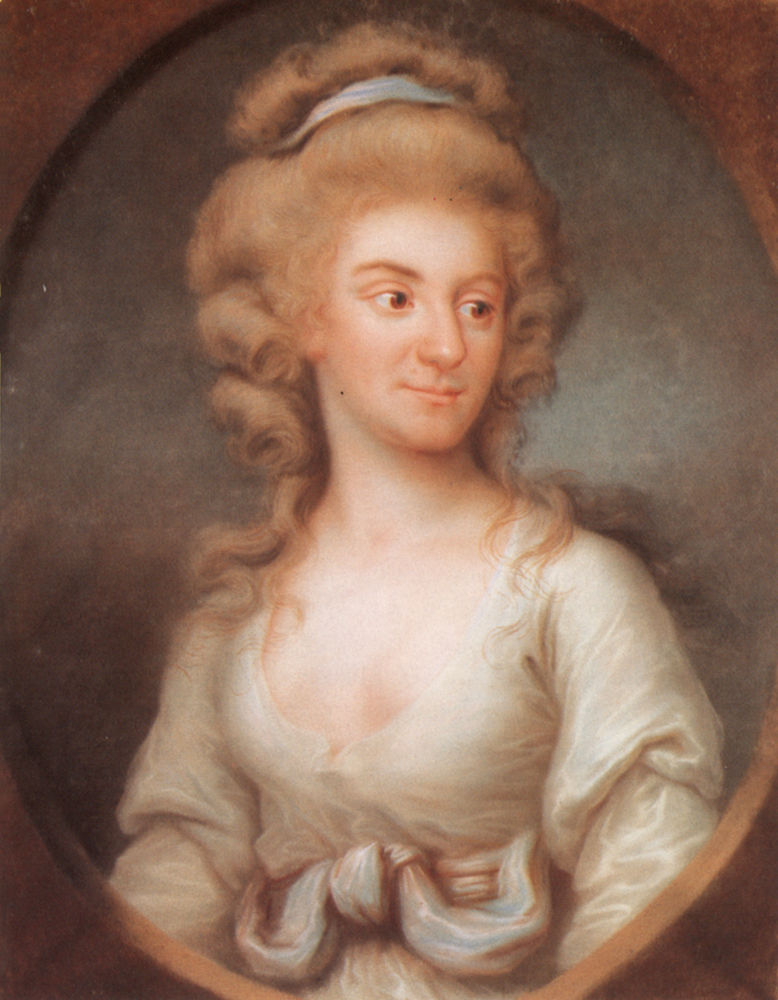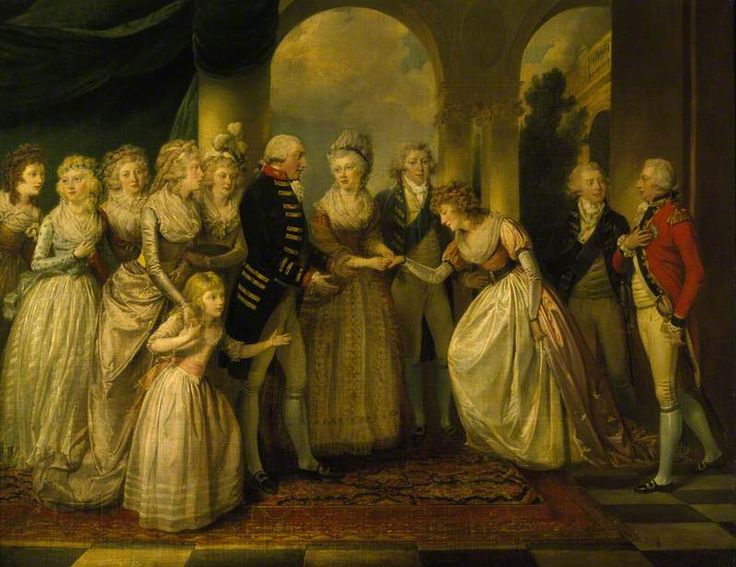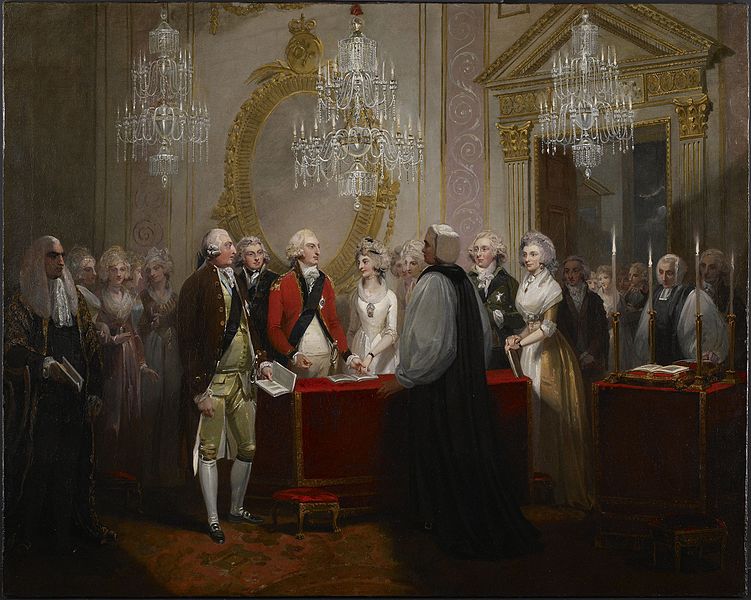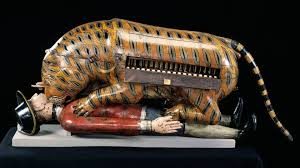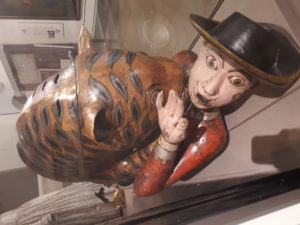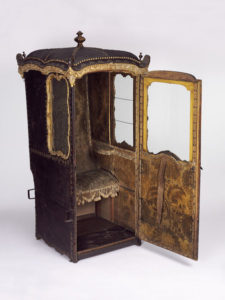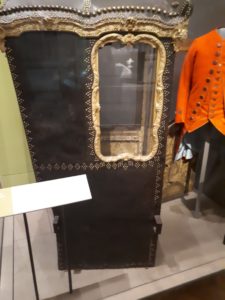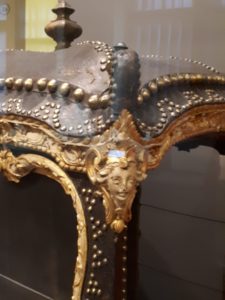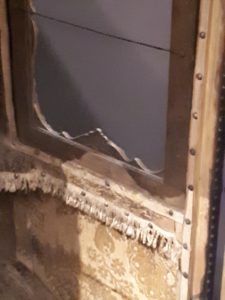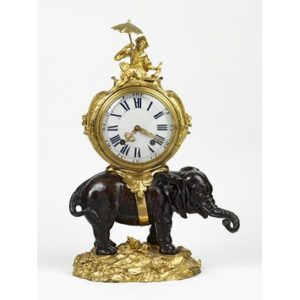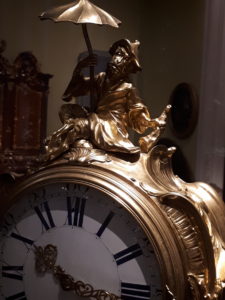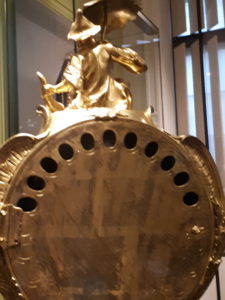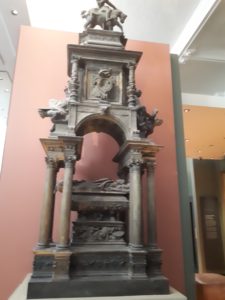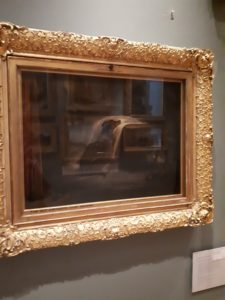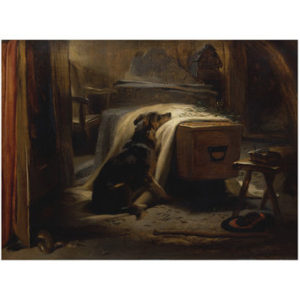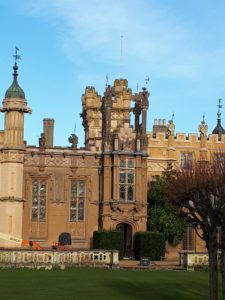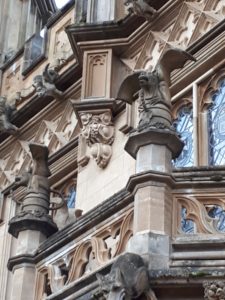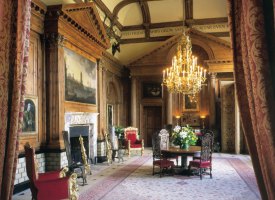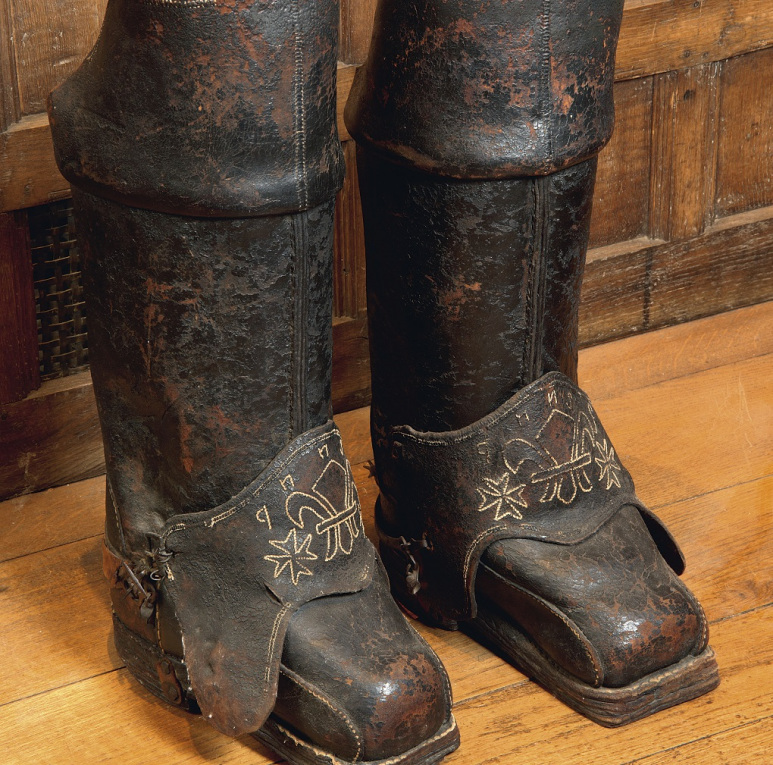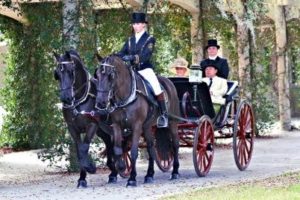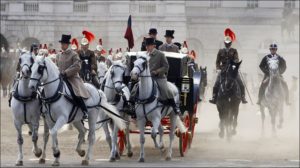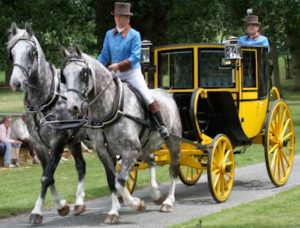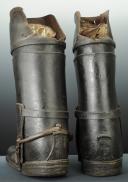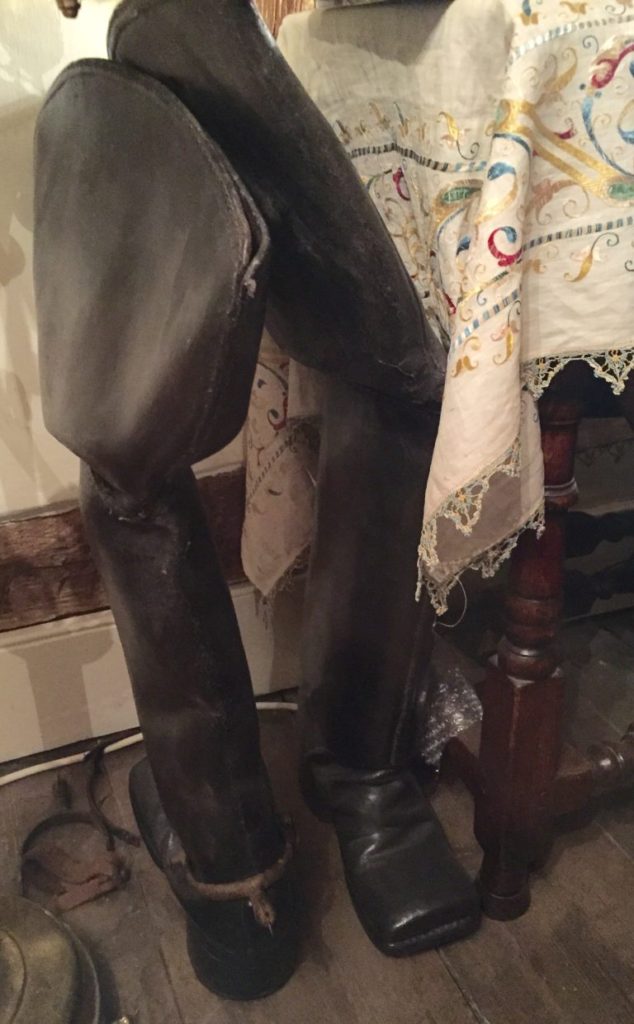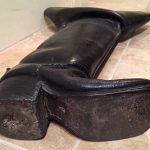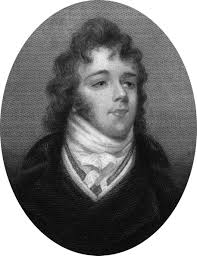
As I have mentioned elsewhere in this series, Frederica, Duchess of York and Beau Brummell enjoyed a singular friendship for more than fifteen years. Prior to his banishment from Court, Brummell was a constant visitor to the Duke and Duchess of York’s residence in Surrey, Oatlands. After his fall and his move to France, the Duchess remained a steadfast friend, becoming almost his sole source of income for many years. Generous and faithful, the Duchess regularly sent money to Brummell, often enclosing the sums with little gifts of her own making, embroideries, drawings, or some token trifle that served to mitigate the charity connected with these gestures.
Before the Duchess’s death in 1820, Brummell had been at work upon a folding screen meant as a gift to her, in part to repay her kindness and, one thinks, in part meant as a genuine mark of his affection for her. Upon learning of Frederica’s death, Brummell put the screen aside and never completed it.
For more information about this mysterious screen, we turn to Captain William Jesse’s excellent book, The Life of George Brummell, Esq., Commonly Called Beau Brummell for his account:
“When Brummell found that his Royal Highness had really closed the doors of Carlton House against him, he cultivated with greater assiduity the friendship that had always existed between himself and the Duke of York, who was never known, in good or ill report, to desert a friend; and his conduct, and that of the Duchess, to the Beau in his exile, were striking instances of the steadiness and sincerity of their friendship. “The Duchess,”says Mr. Raikes, “was a person of excellent taste, and a very nice discriminator of good breeding and manners, and the regard which that Princess entertained for Brummell was highly creditable to him. It may, indeed, be said in favour of the manners of that day, that her Royal Highness often remarked how superior they were to the tone of those that existed at the period of her marriage, when the Duke was surrounded by a set of roue’s who seemed to glory in their excesses, and showed a great want of refinement and courtesy in women’s society. At the time Brummell visited at Oatlands, England had been for many years without a Court, and the limited circle that surrounded the Duke and Duchess of York, though differing scarcely from that of a private family, rendered it the only Royal residence that was the scene of constant hospitality; and it might have been appropriately termed a little Court, in which the affability on the one side, and the affectionate deference on the other, were equally remarkable. Here used to assemble, at the end of the week, Brummell, and all the most agreeable men of the day, intimately acquainted with each other, and sincerely attached to their Royal host and hostess.
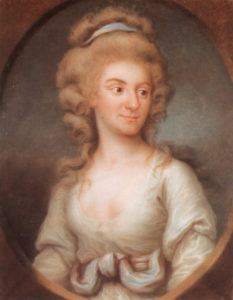
“I am ignorant of the precise dates at which the two following notes from the Duchess to Brummell were written; but they were copied by myself from her autograph, and are inserted as a proof that he must have stood high in her esteem, and that she corresponded with, and received him, on the most intimate footing. The first was written to acknowledge the receipt of a note announcing the loss of a lottery-ticket, which they had purchased together: the paragraph alluding to the chances of his future life is happily expressed, and the sincerity of the concluding sentence was fully proved in after-years, by her generous conduct towards him when she had the pain of seeing that her good wishes turned out unavailing.
Oatlands, ce 20 Septembre.
Vous avez une manière si aimable d’annoncer les plus mauvaises nouvelles, qu’elles perdent par là de leur désagrémens; je ne puis cependant que m’affliger avec vous de la perte de tous nos beaux projets de fête, qui s’évanouissent avec la perte de notre billet de loterie, dont je vous acquitte la dette ci-joint, et y joignent les vœux les plus sincères que ceci puisse être le dernier mauvais tour que la Fortune puisse vous jouer, et que dans toutes les autres circonstances de votre vie, elle puisse toujours vous être favorable. Ce sera me rendre justice que de vous persuader que personne ne peut s’intéresser plus sincèrement à votre bonheur et à tout ce qui vous concerne.
Je n’ai rien à vous dire de ma solitude qui puisse exciter votre curiosité, n’y ayant vu personne de ceux qui vous intéressent depuis votre départ. J’espère que vous reviendrez bientôt dans ces contrées, et qu’il me sera permis de vous réitérer moi-même ici les assurances de l’amitié sincère et de la considération parfaite avec laquelle je suis
Votre toute affectionnée amie et servante,
F.
The next note from her Royal Highness was to thank him for remembering her fete-day, and sending her a beautiful little dog, which Brummell, with his usual good taste, had selected for his present in preference to anything else, knowing the passion his royal friend had for that animal. Her Royal Highness is said to have had at one time upwards of one hundred dogs at Oatlands, and she sometimes erected monuments over her especial favourites: they are grouped round a fountain in the grounds in front of a grotto, to which, during the summer months, she frequently retired with her work or a book. It is, I believe, near this spot that the inhabitants of the parish in which Oatlands is situated erected a monument to the memory of this amiable woman, to which the humblest amongst the parishioners spontaneously requested permission to contribute their mite.
Windsor, ce neuf de Mui.
On ne saurait etre plus sensible que je le suis au souvenir obligeant que vous avez bien voulu me donner au jour de ma fete, et au charmant cadeau que le Due m’a remis de votre part. Recevez mes remercimens les plus sinceres pour ce joli petit chien, e’est l’emblfime de la Fide’; j’aime a me flatter qu’elle sera celui de la continuation de notre amitié, à laquelle je vous assure que j’attache le plus grand prix.
J’ai une toux de cimetière qui menace ruine; si elle ne m’a pas mis sous terre avant le commencement du mois prochain, je compte me rendre à Londres, dans ce temps-là, et un des motifs qui me fait envisager avec le plus de plaisir ce séjour est qu’il me procurera l’avantage de vous y rencontrer et de pouvoir vous réitérer moi-même combien je suis
Votre toute affectionée amie et servante,
F.
“Though the parties at Oatlands were generally, as I have before remarked, of a very unostentatious character, the Duchess’s birth-day was sometimes celebrated with great splendour, particularly the one of 1811, of which I have heard Brummell speak. The King and Princesses were present, and, after they left, the park-gates were thrown open to the public, consisting principally of the tenants and labourers in the neighbourhood, who assembled in the lower part of the house. Here tables were laid out with refreshments, which were soon cleared; and the punch, six quarts of which were placed upon each, having freely circulated, at nine dancing commenced, the Duchess leading off the first dance, called the Labyrinth, with Colonel, now General, Upton.
“Though Brummell read a great deal, his favourite matinal avocation was working at a large screen, which, when finished, he had destined for the Duchess of York; but the pleasure of recording, by this present, his sense of her great kindness, was denied him, for her Royal Highness died before it was completed; he then laid it aside, and never resumed his labours.
“This work of taste and patience is a masterpiece in its way; and had it ever reached Oatlands, many a fair dame and antiquated spinster would have envied its royal owner. The screen measures five feet and a half in height, and, when opened, is rather more than twelve in length; it is divided into six leaves, and the ground is of green paper. The idea of a general design, with which it was evident Brummell had commenced, seems to have been soon laid aside. The most prominent features of it are the quadrupeds, which form the centre of the upper part of each leaf; these prints are on a scale much larger than the generality of the other drawings. In the first compartment is an elephant, the second bears a hyena, the third a tiger, the fourth a camel, and the fifth a bear. The sixth has no animal upon it. Many of the drawings which cover the remaining surface of the screen are coloured: the engravings are in line, mezzotint, or lithograph, with sketches in chalk, pastile, or pencil; in fact, a specimen of every possible variety of the limner’s or engraver’s art, if oils be excepted, is to be found upon it. It “will therefore be easily imagined, that the general effect produced by such a multitude of objects, of every colour and form, is on the first coup d’vil very confused: but, on a closer inspection, the attention that has been devoted to arrangement of almost every part, becomes easily discernible; each little pictorial episode, and there are hundreds, is encircled by wreaths and garlands of flowers of every description; the rose predominating, much to the credit of the paster’s taste; fruit, and emblems in character with the subject to be illustrated, are also mingled with the flowers; to give an exact description of this glorious piece of fiddle faddle, the trifling industry of a thoroughly idle man, would be both useless and tedious. I shall therefore merely attempt a slight sketch, in the order in which I examined it, commencing with the first compartment.
“On this leaf, as I have before remarked, there is an elephant, under the neck of which is a full-faced portrait of Napoleon, who, in this case, is the subject to be illustrated. By introducing this animal the Beau intended to express the Emperor’s power; but on the throat of the modern king-maker is a butterfly, intended to represent another of his attributes, and to neutralize his greatness. The portrait i
s encircled by the neck, shoulder, and trunk of this Chouni; and the edges of the two drawings, which would otherwise have been discoverable, are concealed by other attributes, as well as by fruit and flowers, cut out and arranged with infinite pains. This plan of concealing the edges was pursued throughout with as much nicety as a sempstress would bestow on the hem of a chemise d’/iomme. Amongst these emblems, and immediately above the Emperor’s head, is a mortar elevated for firing; from the mouth of it proceeds a sword, round which a serpent has entwined itself: a scythe and a flag, with the Russian eagle on it, are crossed above the sword, and the trophy is completed by laurel branches over the emblem of Time. The trumpet of Fame, and a port-fire nearly burnt out, are above the Muscovite colours. The reader can scarcely fail to see the application of these illustrations to Napoleon’s history.
“Below the elephant, and in the centre of the same leaf, are grouped four coloured portraits ; the one on the left hand looking outwards is General U (?), next to him are the late Marquis of Hertford and Lord Sefton, apparently in conversation; and the fourth (to me an inconnu) is on their right, and looking towards them. The general, who has a neckcloth large enough for three, and a rounded shirt collar on the same scale, is smelling a sprig of jessamine; a Cupid lolls on his shoulder, as much at ease as the reading Magdalen at Dresden, and is killing, not the general, but Time, with a book, probably Ovid’s Art of Love. On the body of the gallant officer, who is thus indulging poor Cupid with a ride a pig-a-back, is pasted an unnatural and classical looking landscape, representing a forest in the distance, with a rocky foreground; but the principal subject is a young lady, who having thrown aside her harp, is caressing the antlers of a wounded stag. Back to back with the general is the late Lord Sefton, the defect in whose figure Brummell concealed with a flower, probably with the intention of showing that he considered his physical infirmities were entirely overbalanced by his amiable disposition. This he might well do, for he was one of his greatest benefactors. Between his lordship and the marquis is the head of a very lovely woman, ornamented, without the slightest necessity, by a plume of ostrich feathers. The two peers are so placed that it is difficult to say out of whose pocket the divinity is emerging; most likely that of the latter. Lord Sefton is in Hessians, and wears a very peculiar hat. My Lord of Hertford, whose whiskers look as if they were made of leopard’s skin, is dressed in a great-coat, and carries a large cane between a pair of yellow tan gloves, his left hand being inserted, like Lord Sefton’s right, in his pocket behind. His emblems are also highly appropriate and numerous. First, and in the front, are two Cupids in an azure cloud, one bearing the hymeneal torch, and the other a dove, which is looking him amorously in the face. Cupids, in every variety of position that the coryphee of the grand opera could devise, float around his lordship. They may be literally said to swarm; and judging by their looks, each of them seems to be laden with the sweets of a different hive, more luscious than those of Narbonne or Hymettus. One, much larger and more saucy-looking than the rest, is standing on his lordship’s shoulder, and rests, with folded arms, and the domesticated air of a favourite spaniel, upon his hat. To the right is a charming print, by Bartolozzi or Cipriani, of a young girl attended by the everlasting Cupids; above her is a little archer shooting at doves in a palm-tree, and around are Satyrs carrying Bacchantes and Shepherdesses in their arms. Farther on is a gentleman who sports a pair of yellow knee-breeches, and is presenting a nest of doves to a lady in a scarletbodied dress. All these subjects appear to have been applique with great judgment in honour of the most noble the Marquis of Hertford. The inconnu, the last of the quartett, is the counterpart of a piping bullfinch, and by the emblems that surround him may perhaps have been a celebrated “fanatico per la musica.” These portraits are from Dighton’s caricatures.
“The Hyena in the second compartment is represented as being tamed by the Arts, Sciences, and Religion, symbols of which, mingled with the Muses and the Graces, are seen on every side. In the centre of this leaf is a coloured print, taken from a scene in the ” Fille mal gardée.” There are also various drawings representing historical, mythological, and rural subjects. Amongst the most striking are Telemachus relating his adventures to Calypso, Phaeton driving his car, Time his chariot; a French dragoon at bivouac preparing a fowl for the campkettle; a religieuse at her devotions; a minuet at a French fair; a gentleman and a shepherdess, whose dog has seized the skirt of her dress, and with an anxious look is endeavouring to detach her from her admirer.
“The tiger on the third leaf is surrounded by Cupids, cows, goats, &c, all, with the exception of the first, harmless and peaceful animals. On each side of the royal brute is a coloured print, representing the juvenile amusements of the Dauphin and the Duchesse d’Angoulfime. In the one to the right they are playing at soldiers: she is marching in front of her brother and beating a drum, thus indicating the resolute spirit which she afterwards showed: her dog is scampering before her; and her companion, who is dressed in the national colours, is carrying a flag, on which are inscribed the words Union, Force. She has evidently tempted him away from his ninepins to follow her, and these toys are seen behind him scattered on the ground. In the other print they are playing at battledore and shuttlecock, looking very happy and very merry. The ferocious tiger was well chosen to illustrate the period and the subject to which this part of the screen is devoted; for in this beast of prey are plainly personified the cruelties of the Revolution, and, in the domestic animals, the helplessness of those who suffered by its horrible excesses. The children’s ignorance of the nature of the proceedings of which their flag and their tricoloured sashes were the emblems, and their utter unconsciousness of the anxiety and danger which at that very time surrounded them and all belonging to them, as expressed by their game of battledore and shuttlecock, is truly characteristic of their years. Such happily is generally the case with children. In the midst of the dreadful hurricane in which the crew of the Bridge water so nearly perished, and when not. a ray of hope existed for the safety of a soul on board, where were the little children of one of the passengers, and what were they doing? Were they frightened at the unusual trembling of the ship, as she staggered under the concussions of each succeeding wave, or sobbing in their mother’s arms? No; at that awful moment they were floating their little paper boats in the water that half filled the cabins. Below these prints are many other Cupids also, but by no means so comfortable as the one on Lord Hertford’s shoulder. One poor boy is standing, in a cold wretched night, at the door of a house; his torch is thrown down in the snow, and his dripping pinions are scarcely covered by a scanty red mantle. He seems to be a good illustration of the old song, “In the dead of the night,” and is apparently singing the insinuating line, ‘I’ve lost my way, ma’am ; do pray let me in.’
“Near this mischief-maker is another smoking a pipe. Below the camel, in the fourth compartment, is a man in Cossack trousers: a monkey is sitting on his back, gently exciting his own epidermis: a pensive Cupid is clinging to the coat of the incognito. Near him is a gentleman with a lady in his arms; a Cupid is looking up at them, and pointing to a volume of sermons which he holds in his hand: a butterfly has alighted on the cavalier’s coat, and not far off” is a group of Cupids and satyrs rushing in among bathing nymphs. There is also a female barber.
“The bear in the fifth compartment is stimulating his appetite with a young crocodile: around him are children at play, shepherds, the Graces, Venus, and numerous insects and shells. Lower down are portraits, of Charles Fox, Necker, Sheridan, the Regent Philip of Orleans, and John Kemble. Fox has a butterfly near him; Nelson, Greenwich Hospital; Sheridan, a Cupid carousing on some straw; and Kemble, a ladybird on his waistcoat. Round the arm of a man in Hessians is a green monkey holding a mask, and another monkey is between his legs. There are also likenesses of Lucien Buonaparte, the Princess Charlotte, and the Duke of Cambridge when a young man; and a little piece representing an old cure de village trying, but in vain, to thread the needle of one of his pretty parishioners.
“Byron and Napoleon, placed opposite to each other, occupy the upper centre of the last and sixth leaf: the former is surrounded with flowers, but has a wasp on his throat. This to his friend was base ingratitude on the part of Brummell, for the noble lord spoke of, and would have pasted him, with more charitable feeling. Kean, as Richard, is the last print I shall notice. He is below the Emperor, and his neck is ornamented with two hymeneal torches laid together crosswise by a true-lover’sknot.
“It will be seen by this imperfect description that to understand fully the wit shown in the arrangement of all the groups, it is necessary that the observer should be familiar with the gossip of the day; and there is little doubt that any of Brummell’s contemporaries would, with the greatest ease, recognize all.”
It all sounds dizzy making, do admit, yet who amongst us would not dearly love to see this screen, created by the hands and the cheeky mind of the world’s greatest dandy? Where is it? Can it still exist? Captain Jesse saw it with his own eyes in France, thus his minute description of it, but it’s face is unknown. These are the Captain’s last words on the subject:
“When Brummell left Calais, the screen, according to his valet’s version of the affair, was placed in his hands as part payment of a debt. Subsequently, when Selegue’s affairs became deranged, he was obliged to put it in pawn at an upholsterer’s at Boulogne; and it was at this person’s house that I saw it during my short stay in that town. A nobleman, one of Brummell’s former friends, in passing through, was once anxious to buy it, but the gentleman’s gentleman valued his master’s exertions too highly, and foolishly asked seven thousand francs for it, a bargain which his customer very naturally refused. Since that period, another Englishman offered two thousand; this, however, was declined; and when I saw it, the cabinet-maker was fitting it up very handsomely with a mahogany frame, and intended sending it to London, where he hoped to realise a large sum by the sale of it. This screen must have been a fertile subject of conversation for Brummell’s privileged visitors, and to them only was it ever exhibited. To have heard him while employed in cutting out, cutting up, and pasting his dearest friends, and expatiating upon the group that was under his hands at the time, must have been a treat indeed.”
In Part 5, the final in this Series, we learn about the death of the Duchess of York and about her connections to Seven Dials, London.
